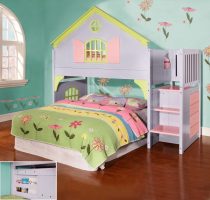The Effect of Color on a Developing Child

Color is everywhere, written on every surface, shading every object, every shape and every form. For a child, the colors that they are exposed to can have a subtle yet profound effect on them as they grow, learn, and develop. While this may be somewhat understated, over time the power of various hues can be accumulative, especially when they are present in a space such as the bedroom. That’s why it is important to understand the effects of the colors in your child’s room so that you can influence this pervasive element.
 While color psychology has been studied, it is not an exact science, and the perceptions of different people will vary widely. This is particularly true in kids, as the way that they see the world can change from day to day as they grow and develop into their more mature selves. However there are certain trends in reactions that people have to colors which tend to run true.
While color psychology has been studied, it is not an exact science, and the perceptions of different people will vary widely. This is particularly true in kids, as the way that they see the world can change from day to day as they grow and develop into their more mature selves. However there are certain trends in reactions that people have to colors which tend to run true.
One basic example of this is red. This color tends to have an exciting effect on people, making them more aggressive, increasing their metabolism, and even making them hungrier. One way this can be relevant in a child’s bedroom is if they are having trouble sleeping at night. Crimson hues in toys, furnishings, and even architectural features may be causing a subconscious problem.
 The answer to this would be to remove as much of the red as possible. A good replacement would be the use of blue decorative objects, which can have the opposite effect, causing a calming and soothing feeling to pervade the atmosphere of spaces where they are used. However this might not be the right color for a child who has trouble staying focused, or waking up in the morning.
The answer to this would be to remove as much of the red as possible. A good replacement would be the use of blue decorative objects, which can have the opposite effect, causing a calming and soothing feeling to pervade the atmosphere of spaces where they are used. However this might not be the right color for a child who has trouble staying focused, or waking up in the morning.
One of the best ways to balance colors is with furniture items and accessories that blend several hues together. Wooden pieces are particularly good at that, as the grains tend to mottle into a wash of tones that can downplay the dominance of any single one. The use of different colored lacquers such as honey, espresso, and merlot can then amplify this effect.









